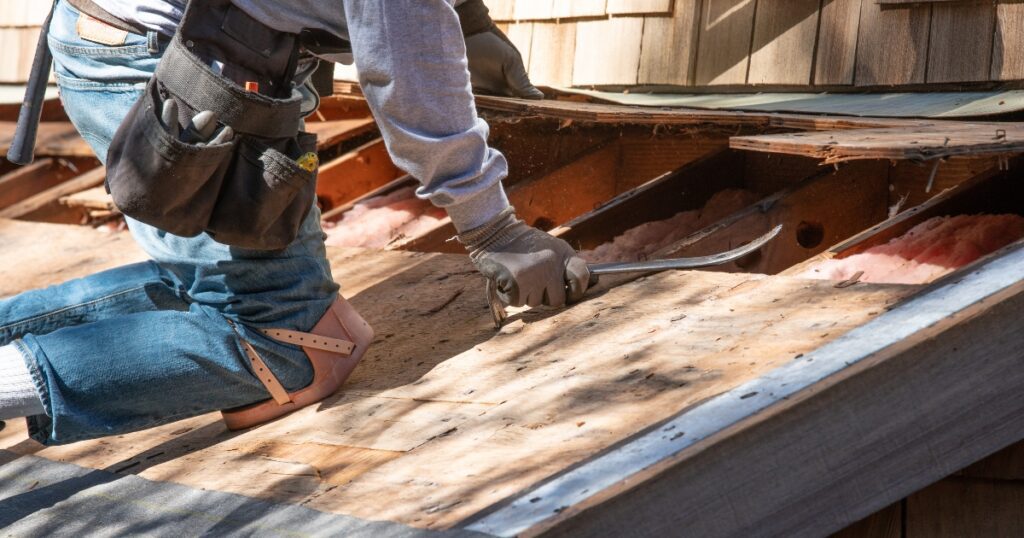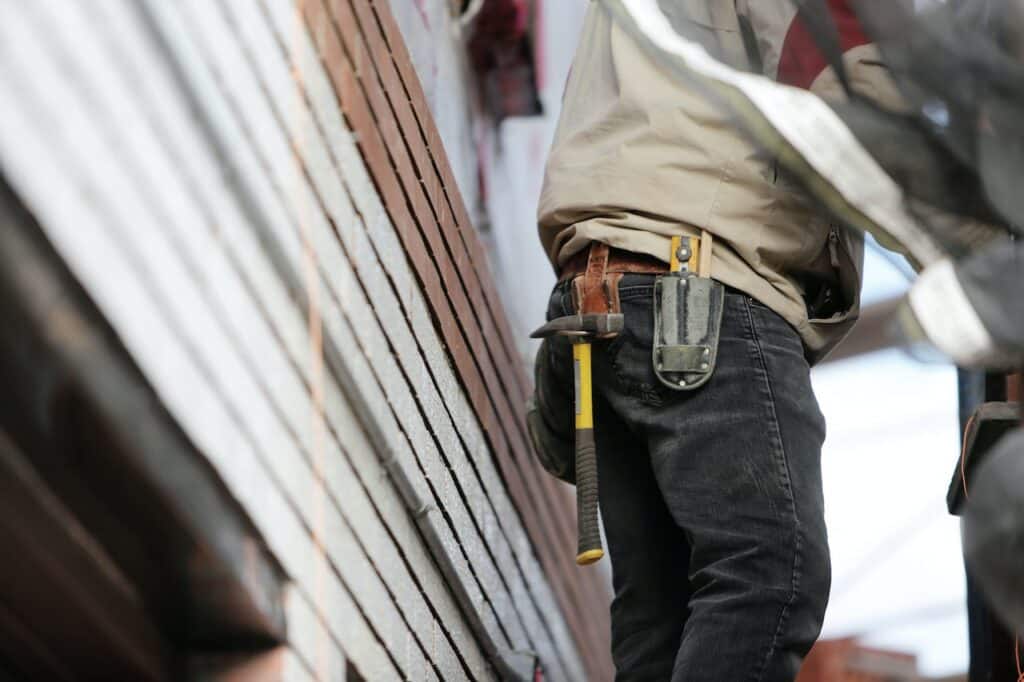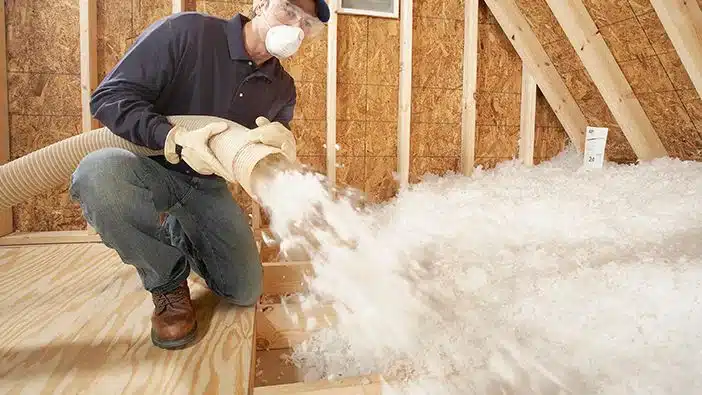
Attic Insulation Removal – Why Is It Important?
Brief Overview of Attic Insulation Removal
Attic insulation removal is the process of removing old or damaged insulation material from the attic space in your home. This can be done for several reasons, including upgrading to new insulation, addressing issues with moisture and mold, or dealing with pests or rodents that may have made their way into your attic. However, removing it can be time-consuming and challenging, depending on the type and amount of insulation you have in your attic.
Importance of Proper Insulation in Homes
Proper insulation is essential for maintaining energy efficiency in your home. Without adequate insulation, the warm or cool air produced by your HVAC system can escape through the attic space, leading to higher energy bills and decreased comfort levels in your home. Additionally, poor insulation can lead to health problems due to exposure to mold spores or dangerous substances that may be present in old or damaged insulation materials.
Upgrading to new attic insulation can improve your home’s energy efficiency while providing a healthier living environment for you and your family. Different types of new attic insulations are available in the market, such as blown-in attic insulation, fiberglass batt insulation, and foam insulation.
However, removing any old attic insulations that might have become damaged by pests/rodents or contaminated with mold is important before installing new materials. Taking the DIY route for removing attic insulation is possible. Still, it’s recommended only if you’re experienced with handling tools safely and familiar with safe handling/disposal methods for hazardous materials like asbestos which was commonly used as an insulating material until the 1970s.
In any case, make sure you’re wearing protective gear, such as gloves, goggles, respirators, etc., while working on removing old attic insulations. In the next section, ‘Signs That Indicate The Need for Attic Insulation Removal,’ we’ll look at some common signs indicating the need to remove old attic insulation.
Signs That Indicate the Need for Attic Insulation Removal
High Energy Bills:
If you notice that your energy bills have skyrocketed for no apparent reason, it could be due to poor insulation in your attic. When you have a poorly insulated attic, the heat that should be trapped inside your house escapes through the roof, making it harder to maintain a consistent temperature.
This means that your heating and cooling systems will have to work harder and consume more energy, leading to higher utility bills. If you find yourself constantly adjusting the thermostat or wearing extra layers indoors, it’s time to inspect your attic insulation.
Presence of Pests or Rodents:
If you hear scurrying noises in your attic or notice droppings on the floor, there’s a good chance that pests or rodents have infiltrated your space. Unfortunately, they can wreak havoc on your remaining insulation by tearing it apart or using it as nesting material.
This reduces effectiveness and creates an unsanitary environment for you and your family. In addition, if left unchecked, these pests can cause extensive damage to your home’s wiring and other structural elements, resulting in costly repairs.
Mold or Mildew Growth:
Mold and mildew growth in attics are common problems caused by inadequate ventilation and insulation. When moisture builds up in an insufficiently ventilated attic space, mold spores can quickly multiply and spread throughout the area. In addition, mold is unsightly and smelly and potentially hazardous to health if left untreated.
It can cause respiratory issues such as asthma attacks and allergic reactions in sensitive individuals. So if you detect a musty smell or see suspicious discoloration on walls or ceilings in your home’s upper levels, it’s best to check out what’s happening in the attic.
If you are experiencing high energy bills, pests or rodents, and mold or mildew growth, it might be time for an attic insulation removal. By taking the necessary steps to remove old insulation and installing new insulation, you can create a healthier living environment for your family while saving money on your utility bills.
Wear protective gear when removing hazardous materials such as vermiculite insulation or fiberglass that may come into contact with skin and eyes. Using the right equipment, such as an insulation vacuum for removing blown-in attic insulation or fiberglass batt insulation, will help make the process easier and safer.
RELATED: Insulation Companies in Dallas: Keeping Your Home Warm and Cozy All Year Round!
Tools and Materials Needed for Attic Insulation Removal
Protective Gear (Gloves, Goggles, Respirator)
Before you start your attic insulation removal project, you must protect yourself from any harmful particles or substances in the insulation. In addition, you’ll need a good pair of gloves to protect your hands from small particles and other debris.
Goggles are also necessary to prevent any fibers or dust from getting into your eyes. Finally, a respirator is crucial, as fiberglass insulation can cause respiratory problems.
Insulation Vacuum
An insulation vacuum is one of the most important tools for your attic insulation removal project. This powerful machine is specially designed to remove old insulation quickly and efficiently. Professionals use this tool because it can remove even hard-to-reach areas in the attic floor joists.
Trash Bags
During your attic insulation removal process, you’ll need plenty of trash bags to safely dispose of all the old materials. Make sure you choose sturdy bags that won’t break open during transport.
Duct Tape
Duct tape is essential when removing old insulation from your attic floor joists as it can help seal up bags of debris and prevent them from ripping open. In addition, use duct tape to seal off any areas where rodents may have gained access.
Removing old attic insulation can be challenging, requiring specific tools and protective gear. Investing in high-quality equipment such as an Insulation Vacuum will make the job easier and ensure it’s done correctly without damaging the space between your attic floor joists or roof structure.
Protecting yourself with gloves, goggles, and a respirator will also prevent unpleasant stinging sensations caused by fiberglass particles and other irritants found in old blown-in or rolled fiberglass batt insulations. Disposing of old materials can also be challenging, but using sturdy trash bags sealed with duct tape will prevent debris from spilling.
It’s essential to properly dispose of old insulation removed from your attic to protect the environment and comply with local regulations. Several factors can contribute to the need for attic insulation removal, including rodent infestation, mold, and water damage.
Contacting attic insulation professionals may be necessary for an initial inspection, especially if you are unsure whether you have fiberglass or blown-in insulation. With the right tools and materials, however, removing old insulation from your attic floor or roof can be done efficiently and safely, boosting your home’s energy efficiency.
Steps to Remove Attic Insulation
Preparation: Clearing the Area Around the Access Point
Before starting with insulation removal, it’s important to clear the area around the access point of any objects or debris. You don’t want anything to get in your way while working. It’s also important to ensure that any living space connected to the attic is sealed off from the insulation removal process.
This will prevent fiberglass or other insulation materials from entering and contaminating your living space. However, one important thing to keep in mind is safety precautions.
When removing insulation, wear protective gear such as gloves, goggles, and a respirator. This will protect you from mold spores and dust particles that can cause serious health problems if inhaled.
Setting up the Vacuum and Trash Bags
Once you have cleared the area around the access point, it’s time to set up your equipment. First, you’ll need an insulation vacuum hose and garbage bags for removing old insulation. It’s best to use heavy-duty garbage bags since regular bags can easily rip due to sharp edges on removed insulation.
Make sure that your vacuum hose is attached correctly and tightly sealed before starting to remove attic insulation. This will ensure that no dust or debris escapes during the process.
Removing Old Insulation
Cutting and removing barriers, such as plastic sheeting, are essential before using a vacuum cleaner to remove attic insulation. When using a vacuum cleaner, start at one end of your roofline/floor joists and work toward another end, methodically removing all old fiberglass or blown-in cellulose insulations while maintaining proper safety precautions. It’s important to remember that fiberglass can be harmful if inhaled over an extended period, so make sure you wear protective gear throughout this whole process.
Cleaning Up Debris
Once you have removed the old insulation, it’s time to clean up the debris. Bag up the removed insulation and seal it with duct tape before disposing of them properly. You can also decide to recycle or repurpose the removed insulation.
It’s important to clean surfaces with a disinfectant after removing attic insulation. This will kill any mold spores that may be present in your attic and prevent them from causing problems in the future.
Removing attic insulation is not easy, but with the right equipment and following these steps, you can do it yourself while maintaining proper safety precautions. In addition, removing old and contaminated insulation from your attic ensures cool air in your home and saves significant energy costs over time.
Disposing of Old Attic Insulation Properly
Local Regulations on Disposal Methods
When disposing of old insulation, following local regulations and guidelines are essential. Many cities and municipalities have specific rules about the disposal of insulation, especially if it’s made from hazardous materials. Sometimes, homeowners must take their old insulation to a designated waste facility or hire a professional removal service.
If you need clarification on the regulations in your area, contact your local government or waste management agency for guidance. They can provide you with information on proper disposal methods and any fees that may apply.
Options for Recycling or Repurposing Old Materials
If you’re looking for ways to be eco-friendly and reduce waste, there are several options for recycling or repurposing old attic insulation. For example, fiberglass insulation can be recycled at certain facilities and turned into new products like glass wool. Cellulose insulation can also be recycled and used as fertilizer or animal bedding.
Another option is repurposing old insulation for other DIY projects around the home. For example, you could use it as protective material when moving fragile items or storing equipment in your garage.
However, it’s unsafe to reuse if the insulation has been contaminated due to rodent infestation or mold growth. Regardless of how you dispose of your old insulation, always prioritize safety precautions during removal.
Safety Precautions During Insulation Removal
Removing attic insulation can be a dusty and dirty job that requires the right equipment and safety precautions. First and foremost, wear protective gear like gloves, goggles, and a respirator mask when handling any insulation material. Before beginning work on blown-in attic insulations, you must seal off all entry points from the attic into the living space below.
This ensures no loose particles drift down into your living space. Choose the right equipment for the job.
Attic insulation removal requires a specialized vacuum designed to handle insulation material, so make sure you rent or purchase this before starting the process. Proper safety and disposal measures allow you to enjoy a cleaner, more energy-efficient home with new attic insulation installed.
Installing new attic insulation
Types of new insulation available
After completing the attic insulation removal process, replace it with a newer, more efficient type. The most commonly used types of new attic insulation are rolled, batt, blown-in, spray foam insulation, and blown-in cellulose insulation.
Your choice depends on your budget, energy efficiency goals, and personal preference. Rolled insulation is made of fiberglass or mineral wool and is a large roll that can be cut to fit between floor joists or wall studs.
Batt insulation is similar to rolled insulation but comes in pre-cut panels. Blown-in insulation is made from recycled materials such as paper or denim and is blown into the attic space using a special machine.
Spray foam insulation is applied as a liquid that expands into foam once it’s sprayed onto surfaces such as walls and floors. Cellulose insulation consists of ground-up newspaper treated with chemicals to make it fire-resistant.
Factors to consider when choosing new insulation
When choosing new attic insulation, you should consider factors such as R-value (a measure of thermal resistance), ease of installation, air quality impact, and cost-effectiveness. R-value determines how effectively the new attic insulation will resist heat transfer.
Insulation with higher R-values provides better energy efficiency but might be more expensive than lower-rated options. Ease of installation also plays a crucial role in deciding which type of new attic insulation to use.
Rolled and batt insulations are easy to install if you have basic DIY skills, while blown-in and spray foam insulations require professional installation services. You should also consider the impact on air quality when installing new attic insulation since some materials, such as vermiculite, contain asbestos fibers that are hazardous to health if inhaled by homeowners during or after installation.
Installing new attic insulation can provide significant energy savings for homeowners with poorly insulated attics. However, choose the type of insulation that best suits your budget, energy efficiency goals, and personal preferences while considering other factors such as ease of installation and air quality impact.
Frequently Asked Questions
Why is attic insulation removal necessary?
Attic insulation removal may be necessary to address issues such as mold or mildew growth, pest infestations, damaged insulation, or upgrading to more efficient insulation materials.
How is attic insulation removed?
Attic insulation is typically removed using specialized equipment such as insulation vacuums and removal tools to safely extract the old insulation, which is then properly disposed of or recycled.
Can I remove the attic insulation myself?
While it is possible to remove the insulation yourself, hiring professionals with the necessary experience, equipment, and knowledge to safely and effectively handle insulation removal, ensure proper disposal, and minimize potential health risks is recommended.
How long does attic insulation removal take?
The duration of attic insulation removal depends on various factors, such as the attic’s size, the insulation’s type and condition, and any additional complications. On average, it can take several hours to a few days to complete the removal process.
Do I need to replace the insulation after removal?
In most cases, replacing the insulation after removal is advisable to ensure proper insulation levels and energy efficiency. A professional insulation contractor can assess your attic and recommend the appropriate insulation material and thickness for optimal performance.
How much does attic insulation removal cost?
The cost of attic insulation removal basics varies based on factors such as the size of the attic, the amount of insulation to be removed, the accessibility of the attic, and any additional services required. On average, attic insulation removal can cost between $1.50 and $3 per square foot.
RELATED: Stay Cozy and Save Big: The Ultimate Guide to Insulation Companies in Dallas
Conclusion
Recap of the importance of proper attic insulation maintenance
The importance of proper attic insulation maintenance must be balanced. Attic insulation is vital to any home’s energy efficiency and indoor air quality. However, paying attention to this aspect of home maintenance can lead to a host of problems that are expensive and time-consuming to fix.
The attic insulation removal process may seem daunting, but it can be done safely and efficiently with the right tools and materials. Signs like high energy bills, pests or rodents, or mold growth should not be ignored.
These signs indicate that there might be a problem with your old attic insulation, which needs to be replaced. Installing new insulation can significantly reduce energy bills and improve indoor air quality, making your living space more comfortable year-round.
New materials like blown-in fiberglass or rock wool offer excellent thermal performance while less hazardous than older materials like vermiculite insulation. However, take all necessary precautions when removing old attic insulation, as fiberglass touches can cause serious health problems.
It’s also important to dispose of old garbage bags containing old insulation properly in accordance with local regulations. With these tips, you can improve your home’s energy efficiency and indoor air quality through proper attic insulation installation and maintenance!






